
A wok is a deep round-bottomed cooking pan of Chinese origin. It is believed to be derived from the South Asian karahi. It is common in Greater China, and similar pans are found in parts of East, South and Southeast Asia, as well as being popular in other parts of the world.
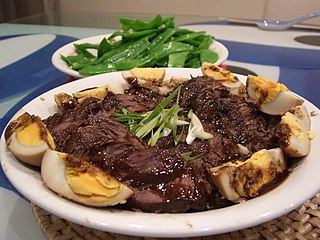
Braising is a combination-cooking method that uses both wet and dry heats: typically, the food is first browned at a high temperature, then simmered in a covered pot in cooking liquid. It is similar to stewing, but braising is done with less liquid and usually used for larger cuts of meat. Braising of meat is often referred to as pot roasting, though some authors make a distinction between the two methods, based on whether additional liquid is added. Osso buco and coq au vin are well known braised meat dishes, and the technique can also be used to prepare fish, tempeh, tofu, or fruits and vegetables.

Grilling is a form of cooking that involves heat applied to the surface of food, commonly from above, below or from the side. Grilling usually involves a significant amount of direct, radiant heat, and tends to be used for cooking meat and vegetables quickly. Food to be grilled is cooked on a grill, using a cast iron/frying pan, or a grill pan.
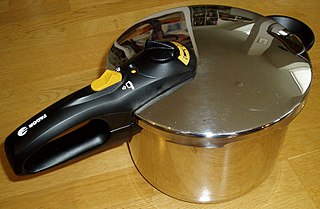
Pressure cooking is the process of cooking food with the use of high pressure steam and water or a water-based liquid, inside a sealed vessel called a pressure cooker; the high pressure limits boiling and creates higher temperatures not possible at lower pressures which allow food to be cooked much faster than at normal pressure.

Cookware and bakeware is food preparation equipment, such as cooking pots, pans, baking sheets etc. used in kitchens. Cookware is used on a stove or range cooktop, while bakeware is used in an oven. Some utensils are considered both cookware and bakeware.
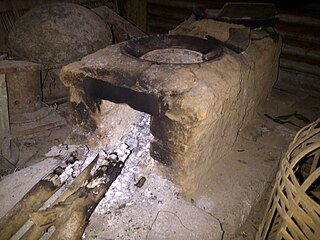
A stove or range is a device that generates heat inside or on top of the device, for local heating or cooking. Stoves can be powered with many fuels, such as electricity, natural gas, gasoline, wood, and coal.

A kitchen stove, often called simply a stove or a cooker, is a kitchen appliance designed for the purpose of cooking food. Kitchen stoves rely on the application of direct heat for the cooking process and may also contain an oven, used for baking. "Cookstoves" are heated by burning wood or charcoal; "gas stoves" are heated by gas; and "electric stoves" by electricity. A stove with a built-in cooktop is also called a range.

A slow cooker, also known as a crock-pot, is a countertop electrical cooking appliance used to simmer at a lower temperature than other cooking methods, such as baking, boiling, and frying. This facilitates unattended cooking for many hours of dishes that would otherwise be boiled: pot roast, soups, stews and other dishes.
The Japanese kitchen is the place where food is prepared in a Japanese house. Until the Meiji era, a kitchen was also called kamado and there are many sayings in the Japanese language that involve kamado as it was considered the symbol of a house. The term could even be used to mean "family" or "household". Separating a family was called kamado wo wakeru, or "divide the stove". Kamado wo yaburu means that the family was broken.

Induction cooking is performed using direct electrical induction heating of cooking vessels, rather than relying on indirect radiation, convection, or thermal conduction. Induction cooking allows high power and very rapid increases in temperature to be achieved: changes in heat settings are instantaneous.

A solar cooker is a device which uses the energy of direct sunlight to heat, cook or pasteurize drink and other food materials. Many solar cookers currently in use are relatively inexpensive, low-tech devices, although some are as powerful or as expensive as traditional stoves, and advanced, large scale solar cookers can cook for hundreds of people. Because they use no fuel and cost nothing to operate, many nonprofit organizations are promoting their use worldwide in order to help reduce fuel costs and air pollution, and to help slow down deforestation and desertification.

Trangia is a line of alcohol-burning portable stoves manufactured by Swedish company Trangia AB in Trångsviken. These stoves are designed primarily for backpackers, with a focus on light weight, durability and simple design. The company began in 1925, selling cookware. The Trangia stove was developed by 1951. Trangia stoves were initially preferred to kerosene (paraffin) pressure stoves because they required only one type of fuel. Trangia's selling point is that the entire packaged stove, including pots, is not significantly larger than a standard camp cooking pot. For this reason the Trangia has retained much of its popularity despite the development of alternative stove fuels and designs.

A cooktop, stovetop or hob, is a device commonly used for cooking that is commonly found in kitchens and used to apply heat to the base of pans or pots. Cooktops are often found integrated with an oven into a kitchen stove but may also be standalone devices. Cooktops are commonly powered by gas or electricity, although oil or other fuels are sometimes used.
The Tommy cooker was a compact, portable stove, issued to the troops of the British Army ("Tommies") during World War I and World War II.
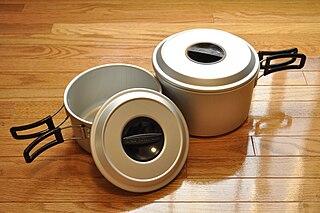
Cooker may refer to several types of cooking appliances and devices used for cooking foods.
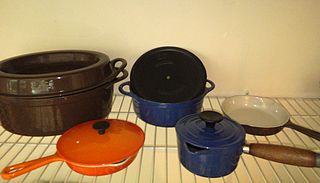
Cousances was a brand of enameled cast iron cookware. originally manufactured by a foundry in the town of Cousances-les-Forges in northeastern France. The Cousances foundry began making cast iron pans in 1553. Four centuries later, in 1957, the brand was acquired by Le Creuset. Cookware under the Cousances brand continued to be manufactured by Le Creuset into the early 1980s.

A multicooker is an electric kitchen appliance for automated cooking using a timer. A typical multicooker is able to boil, simmer, bake, fry, deep fry, grill roast, stew, steam and brown food.

















